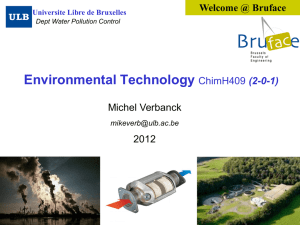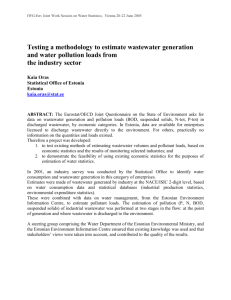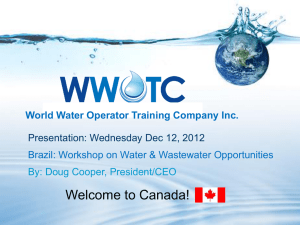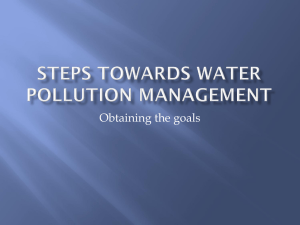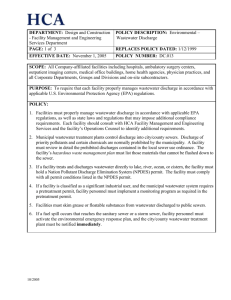City of Nederland Wastewater Treatment Plant Upgrade
advertisement
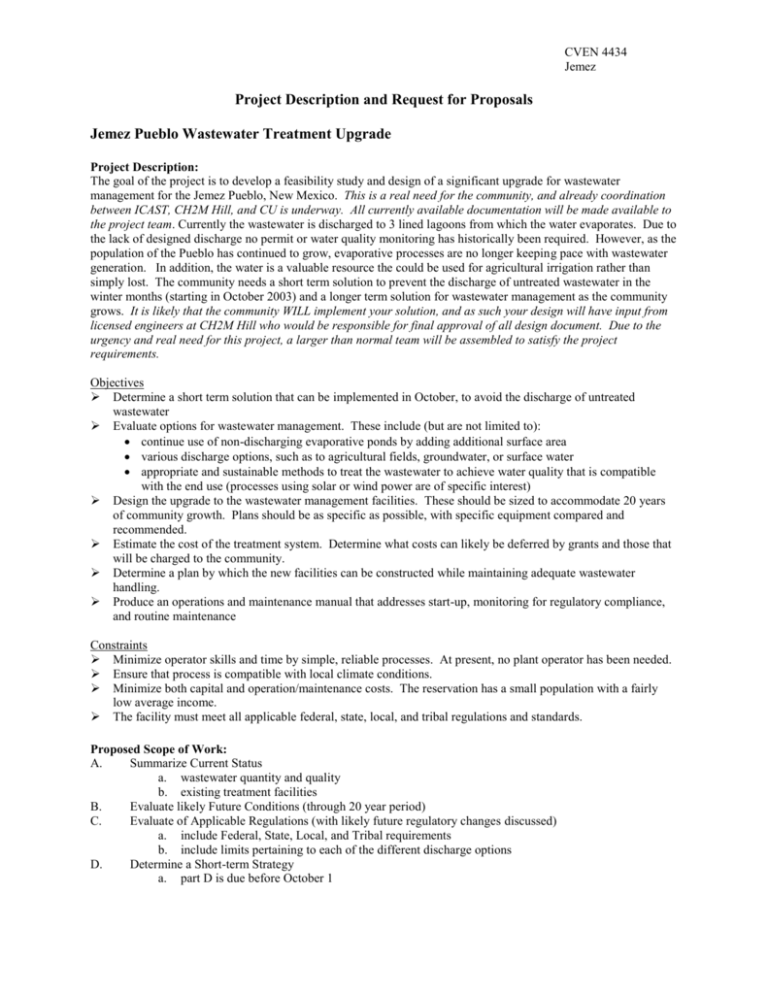
CVEN 4434 Jemez Project Description and Request for Proposals Jemez Pueblo Wastewater Treatment Upgrade Project Description: The goal of the project is to develop a feasibility study and design of a significant upgrade for wastewater management for the Jemez Pueblo, New Mexico. This is a real need for the community, and already coordination between ICAST, CH2M Hill, and CU is underway. All currently available documentation will be made available to the project team. Currently the wastewater is discharged to 3 lined lagoons from which the water evaporates. Due to the lack of designed discharge no permit or water quality monitoring has historically been required. However, as the population of the Pueblo has continued to grow, evaporative processes are no longer keeping pace with wastewater generation. In addition, the water is a valuable resource the could be used for agricultural irrigation rather than simply lost. The community needs a short term solution to prevent the discharge of untreated wastewater in the winter months (starting in October 2003) and a longer term solution for wastewater management as the community grows. It is likely that the community WILL implement your solution, and as such your design will have input from licensed engineers at CH2M Hill who would be responsible for final approval of all design document. Due to the urgency and real need for this project, a larger than normal team will be assembled to satisfy the project requirements. Objectives Determine a short term solution that can be implemented in October, to avoid the discharge of untreated wastewater Evaluate options for wastewater management. These include (but are not limited to): continue use of non-discharging evaporative ponds by adding additional surface area various discharge options, such as to agricultural fields, groundwater, or surface water appropriate and sustainable methods to treat the wastewater to achieve water quality that is compatible with the end use (processes using solar or wind power are of specific interest) Design the upgrade to the wastewater management facilities. These should be sized to accommodate 20 years of community growth. Plans should be as specific as possible, with specific equipment compared and recommended. Estimate the cost of the treatment system. Determine what costs can likely be deferred by grants and those that will be charged to the community. Determine a plan by which the new facilities can be constructed while maintaining adequate wastewater handling. Produce an operations and maintenance manual that addresses start-up, monitoring for regulatory compliance, and routine maintenance Constraints Minimize operator skills and time by simple, reliable processes. At present, no plant operator has been needed. Ensure that process is compatible with local climate conditions. Minimize both capital and operation/maintenance costs. The reservation has a small population with a fairly low average income. The facility must meet all applicable federal, state, local, and tribal regulations and standards. Proposed Scope of Work: A. Summarize Current Status a. wastewater quantity and quality b. existing treatment facilities B. Evaluate likely Future Conditions (through 20 year period) C. Evaluate of Applicable Regulations (with likely future regulatory changes discussed) a. include Federal, State, Local, and Tribal requirements b. include limits pertaining to each of the different discharge options D. Determine a Short-term Strategy a. part D is due before October 1 CVEN 4434 Jemez b. E. F. G. H. I. J. K. L. M. N. O. P. should be fast and easy to implement, low cost, and potentially compatible with the long-term strategy Define project constraints and criteria i. Constrains should be quantified ii. To the extent practical, incorporate stakeholder views in the criteria and weighting iii. Carefully define each criteria iv. Include cost as a criteria, including capital, operation/maintenance, and present value v. Include sustainability as a criteria Evaluate Alternative Discharge Options, including at a minimum: i. No discharge (evaporation) ii. Infiltration (discharge to groundwater) iii. Stream iv. Agricultural Reuse Evaluate Various Wastewater Treatment Options, a minimum of 4 options including: i. Expanding current non-discharging, evaporation ponds ii. Various types of lagoons iii. Various disinfection methods all options should include sustainable power sources such as solar and wind, as appropriate evaluation should include solid (biosolids) and air pollution (odor) issues to fully compare each option, preliminary sizing, layout, and cost estimates will be needed Recommend the Best Wastewater Treatment and Discharge Approach Summarize why this plan is optimal. Design Selected Alternative i. Produce drawings showing the layout of proposed facilities. ii. Run detailed sizing calculations accounting for seasonal climate variability and produce preliminary plan and profile views of the processes. iii. Sizing necessary pipes, pumps, aerators, etc iv. Recommended specific types (model #s) for pumps, aerators, lining, etc and why best v. Hydraulic calculations vi. Include necessary security provisions per new “9-11” requirements for ww facilities Refined Cost Estimate a. include capital costs with detailed breakdown of elements, and potential funding sources b. include O&M costs, and likely user fees Construction of Facilities a. staging of construction operations b. maintaining adequate wastewater treatment during construction c. skills and equipment needed from inside/outside community d. QA/QC Operation and Maintenance Guidelines a. Level of Operator Certification needed, and how to acquire in New Mexico b. Start-up considerations c. Monitoring, including per permit requirements d. Routine maintenance (for pumps, etc) Collection System a. evaluate the suitability of the existing collection system b. recommend methods to verify system integrity c. recommend future upgrades References a. utilize industry standards for design such as EPA guidelines and peer reviewed documents b. complete documentation of sources is required throughout the written reports Public and Client Meetings Describe when and how the local community will be involved in the decision process. Describe when site visits will be conducted, who will participate, approximate date, and what samples and other data will be collected. A presentation of the alternative selection and design shall be made between Dec. 2-11, 2003. Written Reports CVEN 4434 Jemez The short term solution (task D) will be due Oct. 1 The alternative evaluation will be submitted to the client for review, and a draft is due on Oct. 30, 2003. A revised alternative evaluation (addressing comments from the Client) will be submitted with the design by Dec. 11, 2003. Q. Project Management Appropriate project management should be provided throughout the study and should consist of the following items, as a minimum: o complete work within budget limits and on schedule o provide appropriate quality control of the work o coordinate input from local personnel The consultant shall provide a written interpretation of the scope of work (the Proposal), emphasizing aspects of the work requiring specific attention. Recommended revisions or additions to the scope of work and schedule based on Respondent's experience should be presented. Descriptions of specific tasks presented in the proposed scope of work above should be expanded or modified to address any special considerations or approaches. In addition, the Respondent should provide a draft table of contents for the written reports anticipated to be developed as part of the scope of work. The following factors will be considered in the selection of a consultant for this study and design: o quality of proposal in response to the Scope of Work presented above o evidence of a strong start to identifying a short term solution (per task D) and ability to meet this strict time constraint o overall firm experience o quality of staff assigned to the project: experience with similar studies, design experience with similar projects, breakdown of staff time assigned to project o references o cost Presentation of the Proposal and Workplan should be directed to Angela Bielefeldt on Sept. 16 or 18, 2003. Provide a hard copy of the visual aids. Written submissions are due no later than 5 pm, Sept. 18, 2003.




